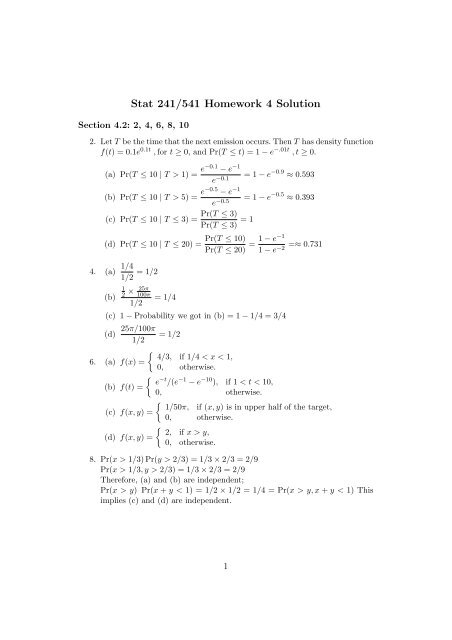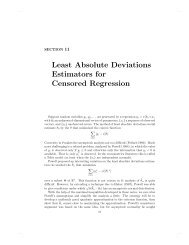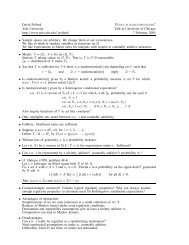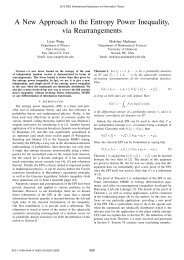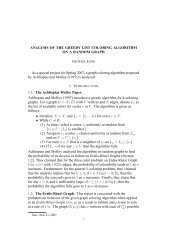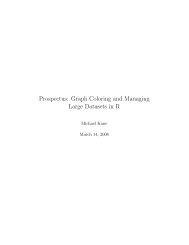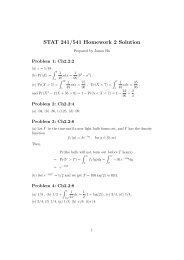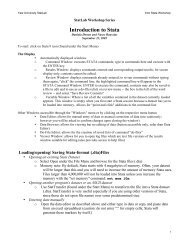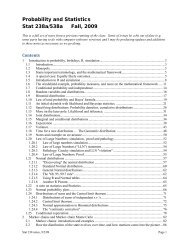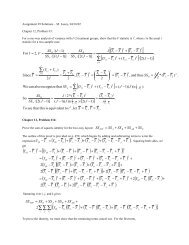Stat 241/541 Homework 4 Solution
Stat 241/541 Homework 4 Solution
Stat 241/541 Homework 4 Solution
- No tags were found...
Create successful ePaper yourself
Turn your PDF publications into a flip-book with our unique Google optimized e-Paper software.
<strong>Stat</strong> <strong>241</strong>/<strong>541</strong> <strong>Homework</strong> 4 <strong>Solution</strong>Section 4.2: 2, 4, 6, 8, 102. Let T be the time that the next emission occurs. Then T has density functionf(t) = 0.1e 0.1t , for t ≥ 0, and Pr(T ≤ t) = 1 − e −.01t , t ≥ 0.(a) Pr(T ≤ 10 | T > 1) = e−0.1 − e −1e −0.1 = 1 − e −0.9 ≈ 0.593(b) Pr(T ≤ 10 | T > 5) = e−0.5 − e −1e −0.5 = 1 − e −0.5 ≈ 0.393Pr(T ≤ 3)(c) Pr(T ≤ 10 | T ≤ 3) =Pr(T ≤ 3) = 1Pr(T ≤ 10)(d) Pr(T ≤ 10 | T ≤ 20) =Pr(T ≤ 20) = 1 − e−1=≈ 0.7311 − e−2 4. (a) 1/41/2 = 1/2(b)12 × 25π100π1/2= 1/4(c) 1 − Probability we got in (b) = 1 − 1/4 = 3/4(d) 25π/100π = 1/21/2{ 4/3, if 1/4 < x < 1,6. (a) f(x) =0, otherwise.{ e(b) f(t) =−t /(e −1 − e −10 ), if 1 < t < 10,0, otherwise.{ 1/50π, if (x, y) is in upper half of the target,(c) f(x, y) =0, otherwise.{ 2, if x > y,(d) f(x, y) =0, otherwise.8. Pr(x > 1/3) Pr(y > 2/3) = 1/3 × 2/3 = 2/9Pr(x > 1/3, y > 2/3) = 1/3 × 2/3 = 2/9Therefore, (a) and (b) are independent;Pr(x > y) Pr(x + y < 1) = 1/2 × 1/2 = 1/4 = Pr(x > y, x + y < 1) Thisimplies (c) and (d) are independent.1
Simulation for 2nd Casey0.0 0.2 0.4 0.6 0.8 1.00.0 0.2 0.4 0.6 0.8 1.0x(b) Let Z be a number chosen with uniform density on the interval [0, a].We find the density for max(Z, a − Z). This density is nonzero only onthe interval [a/2, a]. For x in this interval:Pr(max(Z, a − Z) ≤ x) = Pr(a − Z ≥ Z, a − Z ≤ x) +Pr(Z > a − Z, Z < x)= Pr(Z ≥ a − x, Z ≤ a 2 ) + Pr(Z > a 2 , Z ≤ x)= 2x − aaTaking a = 1, we see that the density for the length of the largest stickfrom the first cut is uniform on the interval [ 1 2, 1]. Assume that thelength of this longest piece is X. Let Y be position on the interval [0, X]of the second cut. Then we obtain a triangle of max(Y, X − Y ) ≤ 1 2 .But by our first computation with a = X and x = 1 2, we see thatThusPr(max(Y, X − Y ) ≤ 1 2 ) = ( 1 − XXPr(triangle) = 2∫ 1123( 1 − xx))dx = 2 log 2 − 1 .


